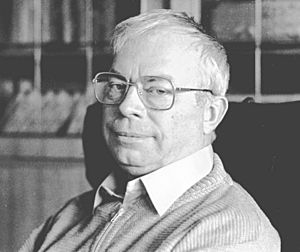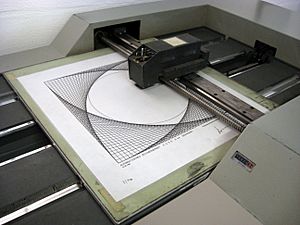Georg Nees facts for kids
Georg Nees (born June 23, 1926 – died January 3, 2016) was a German expert who helped create computer art and generative graphics. He studied math, physics, and philosophy. Later, he became a professor of applied computer science at the University of Erlangen-Nuremberg. Nees is known as one of the "3N" computer pioneers, along with Frieder Nake and A. Michael Noll. They all made computer graphics using digital computers.
Contents
Early Life and Discoveries
Georg Nees was born in 1926 in Nuremberg, Germany. From a young age, he loved both science and art. He enjoyed looking at art postcards and using a microscope. After finishing school in 1945, he studied math and physics at the University of Erlangen.
From 1951 to 1985, Nees worked as a mathematician for Siemens Schuckertwerk in Erlangen. This is where he started writing his first computer programs in 1959.
Later, in 1964, he studied philosophy at the University of Stuttgart. In 1969, he earned his doctorate with a special paper on "Generative Computer Graphics." This paper is considered one of the first important works on creating art with computers. After he retired in 1985, Nees continued to work on computer art and write about it.
Creating Art with Computers
In February 1965, Georg Nees showed the world's first computer graphics that were made with a digital computer. This exhibition, called computer graphik, was held in Stuttgart. This was a huge step for art!
In 1966, he started making "computer-sculptures." He figured out how a computer program could control a machine to carve sculptures instead of just making parts. He showed three painted wooden sculptures and several graphics at an art show in Nuremberg in 1969. His work was also shown at the famous Venice Biennale in 1970, featuring his sculptures and art designs.
In 1963, Nees helped Siemens buy a special drawing machine called the Zuse Graphomat Z64. This machine could draw very precisely. Nees said it was a "great temptation" to use this machine not for technical drawings, but for "useless" things like geometrical patterns.
He used a computer language called ALGOL to create drawings for art and architecture. He even wrote new programs to control the Z64 and create random numbers. In 1965, Nees experimented with random numbers and circle arcs. One famous graphic from this time is Kreisbogengewirre (Arc confusion), also known as Locken. Another computer art pioneer, Frieder Nake, explained that this picture was actually created because of a programming mistake! It was supposed to be simpler, but the error made it more complex and unique.
Nees also used the Siemens System 2002 to make cool graphics, like his well-known artwork called "gravel" (Schotter) from 1968. You can see this artwork at the Victoria and Albert Museum in London. When he wrote the program for "gravel," Nees added commands for random numbers. This made the artwork change from a very organized pattern to a chaotic, jumbled one. If you turn the picture upside down, it looks like it goes from chaos back to order!
Robert J. Krawczyk, an expert, wrote about Nees's "Gravel Stones" artwork: "What attracted me to this piece was the simplicity of the concept and the overall interpretation of transforming order into disorder." He was amazed by how exact math could create such a chaotic image.
Computer Designed Architecture
Nees also used computers to help design buildings. His first computer graphic for architecture was called corridor (Flur) in 1968.
In 1968, Nees started working with architect Ludwig Rase on the Siemens Pavilion for the Hannover Industrial Fair in 1970. The drawings for the special truss roof were first calculated by a computer and then drawn by the Graphomat Z64. These drawings were even used for a poster for the fair and for the Venice Biennale! They also made computer drawings for other Siemens fair pavilions, like one in Brazil in 1971.
Ludwig Rase and Nees also worked on designs for homes and city planning using a shape called a cuboctahedron. The graphic Kubo-Octaeder from this project was used for the cover of an exhibition poster in 1972.
Later Work and AI Art
After retiring in 1985, Nees went back to his research and experiments. He focused on how art and design relate to meaning and beauty.
In 1985, an artist named Alex Kempkens asked Nees to be part of an exhibition called Bilder Images Digital in Munich. Nees agreed and created a whole new series of computer graphics for it. To make these, he gave an AI engine simple commands, some based on philosophy and myths. The computer then used these commands to create different graphics. He wrote the programs in a language called Lisp.
Georg Nees passed away on January 3, 2016, at the age of 89.
Exhibitions and Collections
Georg Nees's work has been shown in many important art exhibitions around the world. His first solo show, computer graphik, was in Stuttgart in 1965. He also participated in famous group shows like Cybernetic Serendipity in London in 1968 and the Venice Biennale in 1970.
His artworks are part of several major collections, including:
- The Museum Abteiberg in Mönchengladbach, Germany
- The Victoria and Albert Museum in London, UK
- The Zentrum für Kunst und Medientechnologie (ZKM) in Karlsruhe, Germany
- The Kunsthalle Bremen in Bremen, Germany
Images for kids




